April 30th, 2018 by IISG
WEST LAFAYETTE, Ind. – Purdue University scientists led a comprehensive analysis of research concerning the effects of microplastics on aquatic life, with the results showing widely different impacts among different types of animals. Strong negative effects were particularly apparent for small animals, such as larval fish and zooplankton, a source of food for many species, suggesting serious potential consequences that could ripple throughout the food web.
Tomas Höök, an associate professor in Purdue University’s Department of Forestry and Natural Resources and director of the Illinois-Indiana Sea Grant College Program, led a team that designed a meta-analysis of research related to the effects of microplastics on aquatic life. The analysis, published in the journal Science of the Total Environment, used results from 43 other studies that each considered the effects of microplastics on consumption of food, growth, reproduction, and/or survival of aquatic animals. The analysis mathematically calculated one or more effect size(s) for each study, then those effects were combined statistically to understand the big-picture effect on animals. The animals included in this study were all aquatic but ranged from fish to mussels to sea urchins to worms.
The most significant findings included:
* Considering all effect sizes together, on average, exposure to microplastics negatively affects consumption, growth and survival of aquatic animals.
* However, the results are highly varied and not all groups of animals were affected in the same ways.
* Microplastics significantly reduced growth, reproduction and survival of zooplankton.
* When exposed to microplastics, larval and juvenile fish see negative effects on natural consumption of other foods.
“One of the types of organisms that seems to be affected is crustacean zooplankton, which are the main prey for many small fishes,” said Höök, whose findings were published in the journal Science of the Total Environment. “The fact that these very small organisms are consuming these microplastics, altering their growth, reproduction and survival, means there could be consequences up the food web. If zooplankton numbers decline, there may be less food available for organisms at higher trophic levels.”
Microplastics, small pieces of the material less than 5 millimeters in size, have been found in waters and soils in and around all seven continents. They come from a wide variety of sources, including broken-down food and drink containers, fibers from synthetic clothing, industrial waste and some beauty products.
Many organizations and governments have tried to reduce the amount of plastic pollution reaching water and wildlife, but the effects these microplastics are having on the range of aquatic life hasn’t been clear. Purdue’s meta-analysis puts all the current, applicable research into perspective.
“Our results most strongly support the notion that exposure to microplastics leads to negative effects on consumption of aquatic organisms, with less compelling and consistent evidence that growth, reproduction or survival of aquatic organisms is negatively affected by exposure to microplastics,” the authors find.
Carolyn Foley, a research associate in Purdue’s Department of Natural Resources and research coordinator for Illinois-Indiana Sea Grant, said few of the studies analyzed included microplastic fibers, the small pieces of plastic that break away from larger pieces. That might be an area to focus future research. She also suggested that while the effects on upper-level functions, such as reproduction and survival, were highly variable, there isn’t a similar summary of research examining how microplastics might be altering aquatic life in less perceptible ways.
“If microplastics aren’t having immediate effects on these upper-level functions, maybe there are less-obvious and cumulative negative impacts,” said Foley, who is the lead author of the paper. “It may be more important to look at finer-level effects, including molecular-level effects.”
The Illinois-Indiana Sea Grant College Program and Purdue’s Department of Forestry and Natural Resources funded the research.
A video of Tomas Höök discussing the effects of microplastics on aquatic life is available at https://www.youtube.com/embed/X6rd-MdAx3A?rel=0.
June 21st, 2017 by iisg_superadmin
This story appears in Lake Michigan nearshore food web: Charting new waters, a new publication created by Illinois-Indiana Sea Grant and Wisconsin Sea Grant.
The Lake Michigan food web is in transition—not just in the question of who’s eating whom, but where fish and other organisms are finding food. In recent years, the nearshore has become the go-to location.
Ben Turschak and Harvey Bootsma, biologists at the University of Wisconsin-Milwaukee, set out to characterize the food web in Lake Michigan by capturing the dynamics of what’s happening in the waters near Milwaukee. They use carbon and nitrogen stable isotopes from fish tissue to learn what they are eating, and to understand where each species fits in the food web.
“Carbon stable isotope ratios tell us what a species eats or its primary energy source,” said Turschak. “Predators have a similar carbon isotope ratio to their prey. For instance, a fish that eats zooplankton might have a very different carbon isotope ratio than one that eats bottom-dwelling insects. By contrast, nitrogen stable isotopes become heavier as they go from a prey source to a predator, so they can reveal where a species is positioned in the food chain.”
The Milwaukee shoreline is characterized by a mixed sand and boulder bottom, with frequent cool water upwellings caused by wind pushing warm surface water towards Michigan. The researchers found the food web there could generally be separated into species that eat phytoplankton or those that dine on algae on the lake bottom in shallower nearshore areas. Generally, however, most fish species have begun to rely more heavily on nearshore energy sources.
The likely culprits in shifting the balance of productivity to the nearshore waters are invasive species. In particular, quagga mussels filter large quantities of water to feed on phytoplankton, this process clears the water and, in shallower nearshore areas, allows more light to reach the bottom. The mussels also excrete nutrient-rich waste that fertilizes the lake bottom. With more light and nutrients, bottom-growing algae can proliferate and support more bottom-dwelling invertebrates and the fish that feed on them.
“On the other hand, in offshore waters, mussels also filter phytoplankton and make the water clearer, but the increased water depth prevents enough light from reaching the bottom to support much algae. As a result, quagga mussels are leaving the deep offshore waters depleted relative to nearshore waters,” said Turschak.
“Decreases in offshore energy sources and increases in nearshore energy sources likely account for the fact that fish appear to be feeding more on nearshore energy sources,” explained Turschak.
The researchers also observed that typical patterns of diet change that occur as fish get larger have also shifted for some species. “This indicates that some fish species may have greater reliance on nearshore energy at particular stages of their life because of these food web changes,” said Turschak.
Illinois-Indiana Sea Grant is a part of University of Illinois Extension and Purdue University Extension.
June 21st, 2017 by iisg_superadmin
This story appears in Lake Michigan nearshore food web: Charting new waters, a new publication created by Illinois-Indiana Sea Grant and Wisconsin Sea Grant.
Round gobies have become big players in the Lake Michigan food web. A small but invasive fish, their success may be due to being masters of survival. More specifically, they make themselves at home in a variety of conditions with a variety of food options, settle in for the long haul, and protect their territory.
IISG Assistant Research Coordinator Carolyn Foley took part in a study to learn more about the round goby’s place in the food web. The research team sampled three sizes of gobies from many locations and in multiple seasons. They analyzed the goby diets using three techniques—stomach contents to learn what the fish are eating when caught, fatty acid signatures, which reveal what they have been consuming over several weeks, and stable isotopes, providing a picture of an even longer time frame.
They found location was the driving factor in terms of what the gobies ate and the fish tended to stay put over time. “It’s striking how they tend to stay in the same spot,” said Foley. “This makes sense for them because they are very territorial—they aggressively defend their home turf.”
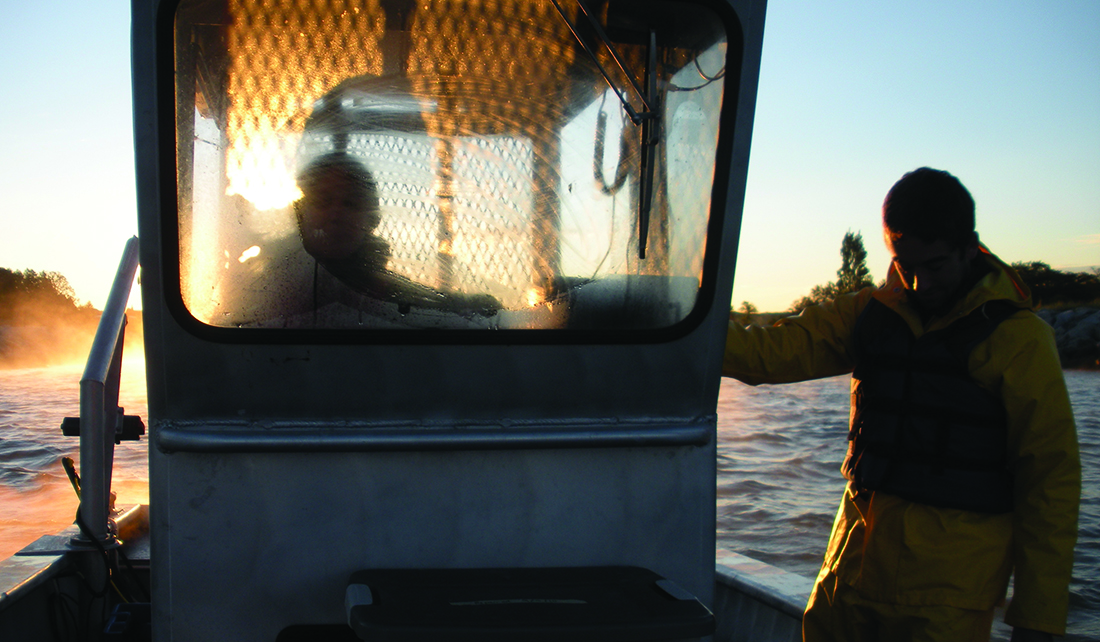
University of Illinois graduate student Austin Happel and Carolyn Foley, Illinois-Indiana Sea Grant assistant research coodinator, head out to collect fish and invertebrate samples in the waters near Manistee County. Photo by Sarah Stein
Gobies are known to prefer hard, rocky areas and to eat zebra mussels, but the reality may be more complicated. “We caught more gobies over hard substrate, which makes sense, but we found them over soft substrate too,” said Foley. “And since the diet analysis—stomach contents, fatty acids, and isotopes—are conveying the same information no matter what the timescale, we think it means they are taking advantage of whatever food sources are nearby.”
That gobies have become major players in Lake Michigan and that they are survivors may have the potential of providing some stability to the food web. “Their adaptability suggests that they will likely persist for a long time,” said Foley. “And as part of the food web, they too are being eaten—smallmouth bass and birds are eating gobies and are growing.”
But this brings up a concern. As bottom dwellers, round gobies hang out where the contaminants are. As these fish become entrenched in the food web, scientists wonder whether contaminants are more likely to move up through the food web to birds, top predator fish, and eventually, people.
Illinois-Indiana Sea Grant is a part of University of Illinois Extension and Purdue University Extension.
June 2nd, 2017 by iisg_superadmin
This story appears in Lake Michigan nearshore food web: Charting new waters, a new publication created by Illinois-Indiana Sea Grant and Wisconsin Sea Grant.
While the influx of invasive species has taken a toll on the Lake Michigan food web, the loss of habitats like coastal wetlands may be having impacts too. Researchers who are looking at how coastal wetlands contribute to lake habitats have, thus far, documented that various fish species like yellow perch and smallmouth bass use these wetlands at various points in their lives.
Biologists Gary Lamberti, University of Notre Dame, and Patrick Forsythe, University of Wisconsin-Green Bay, are leading a team whose goal is to quantify the role of coastal wetlands in sustaining sportfish. The project is in progress, but is making promising steps forward.
They are building the food web in wetland and nearshore habitats at nine paired wetland-nearshore sites around Lake Michigan, with the wetlands representing a variety of landscapes and distances from the lake. The scientists are using three measures from 50 species of fish, both prey and predators, to map out the story. The first two measures are commonly used—carbon and nitrogen stable isotopes. Carbon isotopes reveal location in terms of food source. It reveals what the base of the food web looks like.
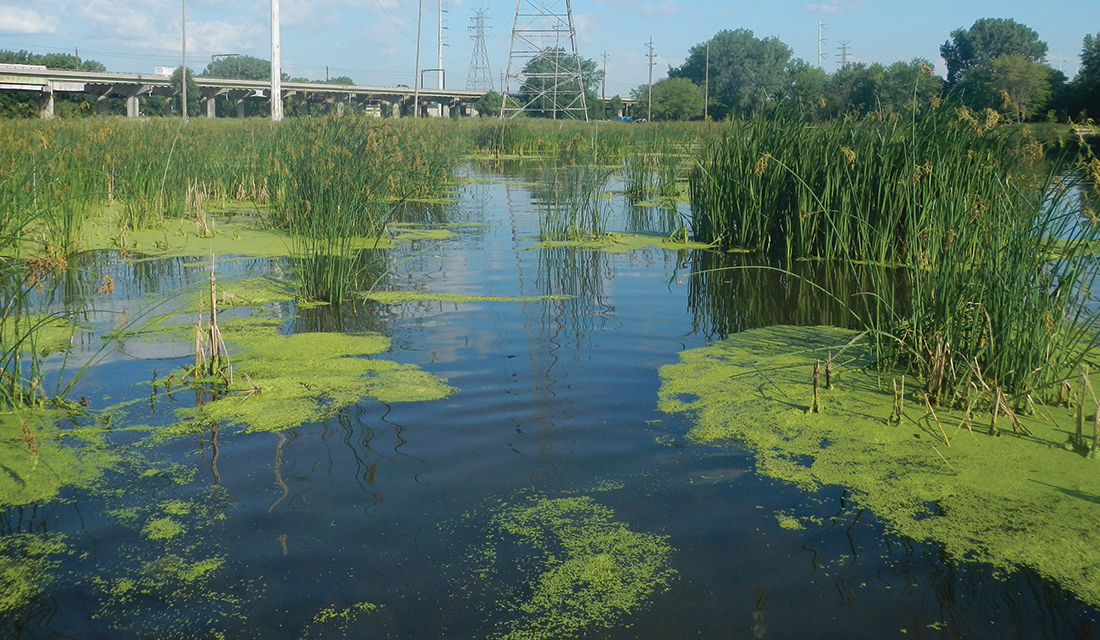
The newly restored Roxana Marsh in Indiana provides a study site for assessing the importance of wetlands to Lake Michigan sportfish.
“In a wetland, carbon cycling happens faster than in nearshore waters so the carbon signature is more depleted and that gets propagated up the food chain,” said Katherine O’Reilly, who has taken on this work as part of her doctorate at Notre Dame.
The nitrogen isotope indicates where a species sits in the food chain and can reveal what species are more predatory and are eating other fish versus those that are primary consumers, eating solely invertebrates or zooplankton.
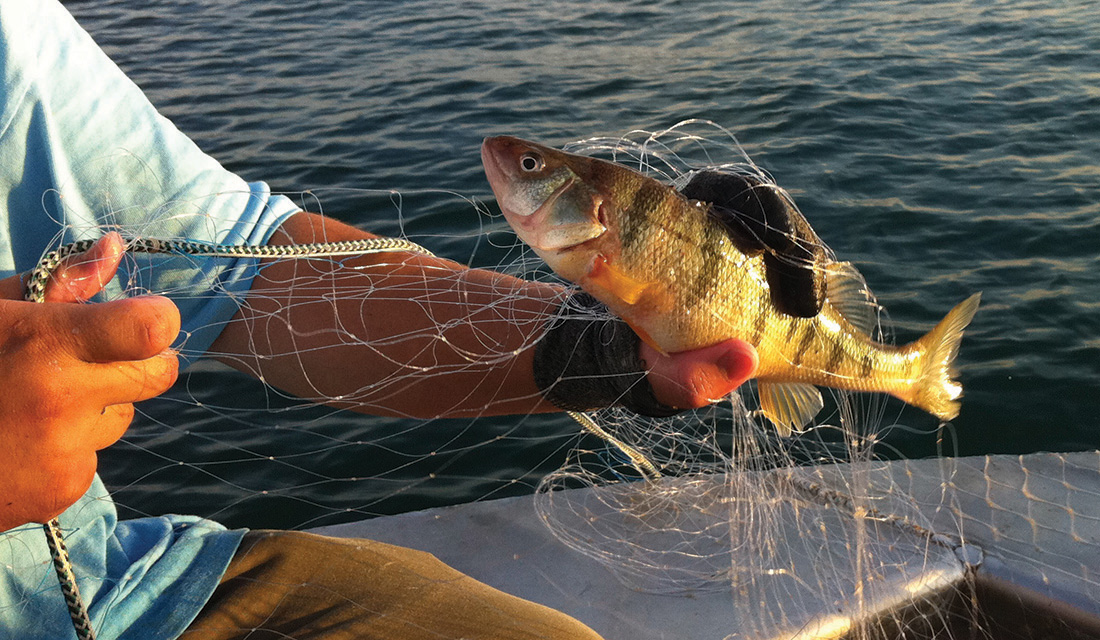
Nearshore areas, including wetlands, may play important roles to yellow perch and other sportfish.
The third measure is a technique first pioneered in marine studies. The researchers are analyzing trace element chemistry of otoliths, which are fish ear bones. Since they are always growing, otoliths provide a timeline of where the fish have been.
“The otolith is comprised of trace elements in the water and we’ve learned that water samples from wetlands and the nearshore are very different,” said O’Reilly. “We have found in the otolith that the fish are using wetlands at different times in their life cycles. This preliminary look at the microchemistry reveals that important sportfish like yellow perch and walleye are not staying in one habitat,” said O’Reilly. “They are moving energy between wetland and nearshore waters.”
As analysis progresses further, the researchers will be able to understand more about the connection between the two habitats. Ultimately, they are hoping to demonstrate the value of wetlands to the lake food web and sportfish.
“The question might need to be answered: How much is a wetland worth to a fishery?” said O’Reilly.
Illinois-Indiana Sea Grant is a part of University of Illinois Extension and Purdue University Extension.
April 17th, 2017 by IISG
Weatherfish, known in scientific circles as Misgurnus anguillicaudatus, were spotted in the recently restored Indiana wetland, Roxana Marsh, by researchers from the University of Notre Dame.
PhD candidate Katherine O’Reilly, who led the team that confirmed the weatherfish finding, was at the marsh in 2015 for an IISG-funded project evaluating how coastal wetlands around Lake Michigan support the nearshore lake food webs.
“The main goal of the project is to figure out how fish moving between these habitats might be moving energy,” O’Reilly said.
“You might have fish moving out to the nearshore and becoming prey for larger sport fish. That moves food, energy, and nutrients from these highly productive coastal wetland systems to the less productive lake habitat.”
When the researchers returned to their nets left out overnight as part of routine sampling, what they saw was baffling. After some “on-the-spot Googling,” they figured out what they had.
“I wasn’t familiar with the weatherfish. I saw these little eel-like things, something I wasn’t used to seeing in the Great Lakes,” O’Reilly said. “We must have just hit the weatherfish jackpot.”
The weatherfish, originally from Eastern Asia, has been in the United States since the early twentieth century. It was brought over through the aquarium trade. Anglers also have used them as bait because of their wriggly disposition. They are greenish-grey-brown and are typically less than eight inches.
They found their way to Cook County’s North Shore Channel in 1987 and the Chicago Sanitary and Ship Canal in 1994. By 2005, a survey confirmed their presence in the West and East branches of the Grand Calumet River and the Indiana Harbor Canal.
But what’s particularly unique about this species is its breathing anatomy. The weatherfish can use their intestine to supplement their gills when oxygen conditions in the water are low. They’re tolerant in what are considered rough, degraded habitats.
In fact, that lung structure is what gave the weatherfish its name. Because they have an intestine that can take in air, they’re very sensitive to changes in barometric pressure. There are reports of when there are drops in pressure, they start to get increasingly active in anticipation of an impending storm.
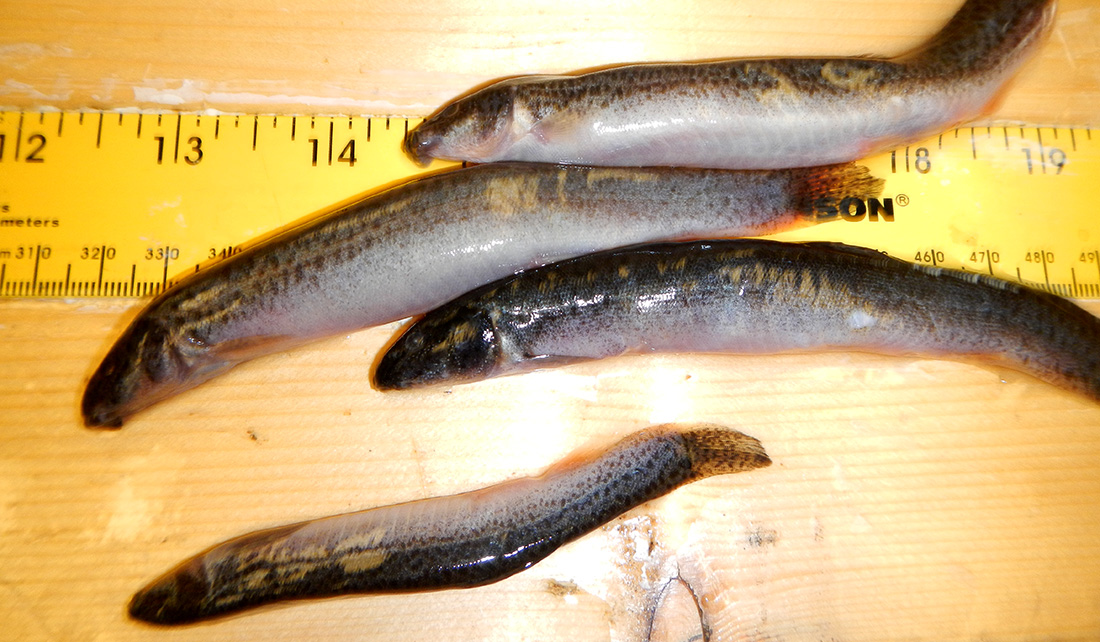
Some of the Roxana Marsh weatherfish were brought back to the lab at University of Notre Dame for further analysis.
Many of the fish O’Reilly and (then) undergraduate Amelia McReynolds pulled up in their nets that day were females filled with eggs, which made O’Reilly think that they may have been spawning in the marsh. Through further investigation, they found that the weatherfish diet of small benthic invertebrates and insects was similar to that of some native fish. She posits that could potentially have an impact down the road if they out-compete the native fish for resources.
Gary Lamberti, O’Reilly’s adviser, was impressed by his students’ findings.
“It really is the most exciting thing in science when you’re doing some routine work and you’re expecting the usual and then you find something that’s very different,” Lamberti said.
“Having serendipitous discoveries really makes science and ecology very interesting and rewarding.”
*This story was updated on April 28, 2017.
To learn more about how to prevent the spread of aquatic invasive species, visit Be A Hero—Transport Zero™
Illinois-Indiana Sea Grant is a part of University of Illinois Extension and Purdue University Extension.
March 27th, 2017 by Irene Miles
A collaborative research project about the impacts of quagga mussels in Lake Michigan has led to more funding for the issue from the National Science Foundation (NSF). The original project, jointly supported by the Illinois-Indiana and Wisconsin Sea Grant programs, looked at the effects of this invasive mussel in the deep parts of Lake Michigan on plankton abundance, the phosphorus cycle, and water movement.

Harvey Bootsma
The new project is funded by the Biological Oceanography and Physical Oceanography divisions of NSF for more than $1 million with the expectation that the results will be useful in understanding conditions in other large lakes as well coastal areas.
The principal investigators are Harvey Bootsma and Qian Liao with the University of Wisconsin-Milwaukee,
and Cary Troy with Purdue University. David Cannon is a Ph.D. student working on the project at Purdue.
In the original project, the team discovered that quagga mussels in Lake Michigan are eating more plankton than what is reaching them by sinking from above. They’ll be looking at how and why this could happen with the new project.
“We think that food delivery to the bottom of the lake is not just determined by the passive settling of phytoplankton as it’s sinking through the water, but that

Cary Troy
plankton is always being circulated in the lake,” said Bootsma. “It’s like the plankton are on a kind of conveyor belt where they’re going up and down.”
The researchers now will be studying turbulence in the entire water column.
Troy studied the impact mussels have on water movement as they filter it—sucking in water and spitting it
out. “Although this filtering has a dramatic effect on water quality, we found that quaggas do not strongly influence movement throughout the entire water column,” explained Cannon.
But the movement they cause in the thin layer immediately above the lake bed—a

Qian Liao
phenomenon consistent throughout the year thanks to stable temperatures at the bottom of Lake Michigan—is an element missing from most mussel filtration models.
The researchers also found that the mussels are changing the phosphorus cycle in the lake. “The nutrient-loading models used to set limits for phosphorus aren’t accurate anymore because of these new components to the ecosystem – bottom-dwelling filter feeders,” Bootsma said. “They have changed the rules for how Lake Michigan works.

David Cannon
“Lake managers have a conundrum right now. They’ve got too much algae in the nearshore zone and they want to reduce phosphorus to solve that problem. But there’s not enough phytoplankton in the offshore zone because of the mussels. So if they reduce phosphorus loading in the lake, they could make that offshore problem even worse so that there’s virtually no food left out there for the rest of the food web,” Bootsma said.
With the new project, Bootsma said his team hopes to determine what the “sweet spot” is for phosphorus loading. “There may not be one perfect phosphorus load that solves both the nearshore and offshore problem, but we’d like to try and find one that minimizes the nuisance algae while at the same time keeps the offshore animals alive with enough plankton production.”
The NSF project will start this spring. “Although we’re focusing on Lake Michigan, the work has implications for most of the other Great Lakes as well as other lakes in general that are being invaded by mussels,” Bootsma said. “We’re looking at a fundamental change in the way lakes work, and that’s the kind of thing the NSF is interested in.”
 “It’s generally accepted that the ecosystems of smaller, shallower lakes—Lake Erie, for example—are at the greatest risk of quagga mussel invasion,” Cannon added. “Our results could help show other researchers that the effects of mussels on large, deep lakes cannot be ignored and, more importantly, how they can be accounted for.”
“It’s generally accepted that the ecosystems of smaller, shallower lakes—Lake Erie, for example—are at the greatest risk of quagga mussel invasion,” Cannon added. “Our results could help show other researchers that the effects of mussels on large, deep lakes cannot be ignored and, more importantly, how they can be accounted for.”
Irene Miles, IISG coordinator of strategic communication, contributed to this post.
Illinois-Indiana Sea Grant is a part of University of Illinois Extension and Purdue University Extension.
January 10th, 2017 by IISG
Researchers at Purdue University are suggesting that fishing by Lake Michigan charter boat anglers has changed in recent years—and the scientists didn’t even have to visit the lake to notice these differences.
In fact, Nicholas Simpson who is the primary author on the study has never even fished Lake Michigan.
Working with Tomas Höök, fisheries ecologist and IISG associate director for research, Simpson, then an undergraduate, compiled 21 years of charter fishing data obtained from the Illinois, Michigan, and Wisconsin Departments of Natural Resources (DNR).
The data, derived from more than 500,000 trips, were readily available from the records charter anglers are required to report to their state DNR after each trip: number of fish harvested—not just caught, location fished, and hours spent fishing.
Simpson, Höök, and their co-authors evaluated patterns for five salmonid species—brown trout, Chinook salmon, coho salmon, lake trout, rainbow trout—harvested from May to September during 1992–2012.
“Because we’re looking at charter fisherman data, there are some biases,” Höök acknowledged. “They’re not randomly going out to catch fish. They go where they believe they’re more likely to catch fish.”
But there is an advantage to examining these data. Researchers often attempt to catch fish in a systematic, unbiased way, and may be limited by factors, such as funding timelines or resources. As a result, “the number of times the lake is fished or the overall number of fish caught wouldn’t be that much,” Höök pointed out. “Here we’re taking advantage of a huge number of people fishing over a long time period.”
The data set covers a time when the lake itself has changed dramatically. Lake temperature and other physical and biological factors are different today than they were in 1992. Over the course of the data set, the distribution and number of prey fish, such as alewives, available for salmon varied greatly.
In addition, while it may be hard to remember a time when zebra and quagga mussels—invasive filter feeders—didn’t line almost every inch of Lake Michigan, zebra mussels were just becoming an issue in the first year of data. Numerous studies have suggested that the mussels have changed the structure of the Lake Michigan food web over time.
The researchers assumed that salmonid species would not be immune to these changes, and some patterns emerged from the charter anglers’ records.
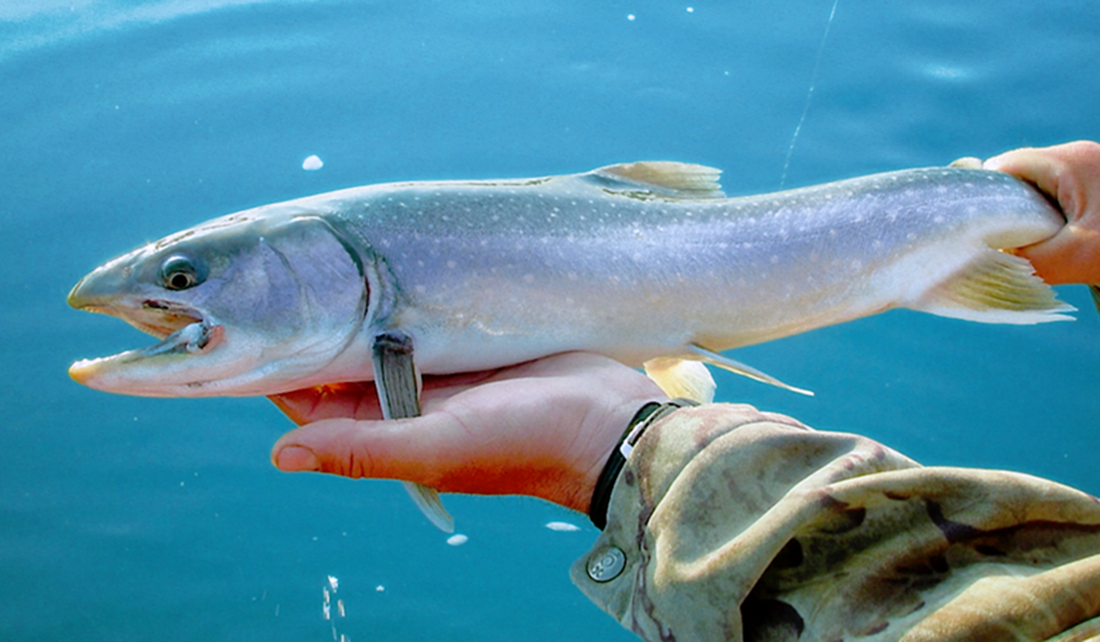
Over time, the amount of time charter anglers spent fishing increased. The anglers also shifted their efforts closer to shore and toward the western and northern parts of Lake Michigan. However, patterns in the harvest of individual salmonid species paint a complicated picture.
Harvest of lake trout and rainbow trout by charter anglers shifted closer to the shore. The same was not true for Chinook and coho, where harvest was consistently farther out in the lake. Brown trout were harvested progressively further west and south, while lake trout were harvested progressively further east. Multiple species were harvested in new locations and at new depths.
In general, the researchers suggest that many of the changes are related to salmonid feeding.
“Previous research has shown the brown trout and rainbow trout and to an extent lake trout are a little more flexible in their diets,” Simpson said. “They were more apt to shift closer to shore and to shallower depths for food. Chinook salmon and coho salmon may not have displayed those trends because they’re more reliant on alewife as prey, which tend to live farther out in the lake.”
“There’s no previous research in the literature that would suggest that coho or Chinook salmon would vary their diet as much as the other three species,” Simpson added.
The researchers stopped short of definitively declaring that fish are changing where they dwell in response to changes in distributions of Lake Michigan nutrients and prey, but they’re confident the results from this paper will be useful.
“The depth and breadth of this data set is what makes it powerful,” said Höök. “While we have to be aware of the biases, fisheries researchers do use catch and harvest data to infer species distributions.”
And while fisheries managers will ultimately need to consider this analysis alongside their own monitoring efforts, Simpson said, “I think it’s useful for fisheries managers especially on Lake Michigan to be able to see that there are shifts occurring.
The study on their findings was recently published in the Journal of Great Lakes Research.
Illinois-Indiana Sea Grant is a part of University of Illinois Extension and Purdue Extension.
November 16th, 2016 by IISG
The first of hopefully many recreational fishing workshops brought together more than 40 researchers, managers, stakeholders, and anglers last week to Hammond Marina in Indiana to learn about food web research, updates on fisheries, and ongoing monitoring in southern Lake Michigan.
Mitchell Zischke, IISG research and extension fishery specialist, organized the event.
“I have presented research at similar workshops for Lake Huron hosted by Michigan Sea Grant. These workshops were well attended and a great opportunity for anglers, scientists, managers, and others to interact,” said Zischke. “I wanted to develop a similar program for southern Lake Michigan, particularly in light of recent ecosystem and fishery changes like the declining populations of alewife.”
The five speakers hailed from NOAA Great Lakes Environmental Research Laboratory, U.S. Geological Survey Great Lakes Science Center, U.S. Fish and Wildlife, Ball State University, and Illinois Natural History Survey.

Mitchell Zischke, IISG research and extension fishery specialist, pictured on the right, organized the event.
Topics included recent changes in the base of the food web, status and trends of prey fish, mass-marking of Chinook salmon and lake trout, long-term monitoring of yellow perch, and angler surveys and the recreational fishery focusing on the Illinois waters of Lake Michigan.
Howard Petroski, known as “Captain Ski,” ran Paradise Charters out of East Chicago for 25 years until it shut down about 14 years ago. Even though he now just fishes recreationally, he still follows what’s happening in Lake Michigan.
“What they’re showing with the decline of the perch was pretty obvious, but now it’s more obvious that they showed it on the charts,” Petroski said.
According to Zischke, this first workshop just scratched the surface on topics relevant to anglers in southern Lake Michigan.
“There were actually more people willing to present than I could fit in the workshop agenda. We hope that these workshops can become an annual event in both Indiana and Illinois, that way we can continue to provide anglers and other lake-users with up-to-date information on the Lake Michigan fishery and ecosystem as a whole. In fact, attendees at our recent workshop said that they can’t wait for the next one!”
Illinois-Indiana Sea Grant is a part of University of Illinois Extension and Purdue Extension.
March 17th, 2014 by iisg_superadmin
Research into the Lake Michigan food web has increased in the last decade, but there are still a lot of questions—exactly what is eating what, and how is that dynamic affected by environmental changes? To find answers to these and other questions, researchers from federal and state agencies, universities, and non-profit organizations will come together next month in Ann Arbor, MI. The two-day meeting will feature discussions on past and current food web studies and end with a plan for future research.

The meeting kicks off April 1 with presentations on several Sea Grant- and EPA-funded studies. IISG’s Tomas Hook, Sergiusz Czesny, director of the Lake Michigan Biological Station, and Bo Bunnell of the USGS Great Lakes Science Center will discuss the state of Lake Michigan fish populations, including the results of a three-year investigation of the differences in nearshore food webs across the lake. Harvey Bootsma, a researcher at the University of Wisconsin-Milwaukee, and NOAA’s Henry A. Vanderploeg will also be onsite to talk about recent findings on the diets of phytoplankton, algae, and other species at the bottom of the food chain. Additional presentations, orchestrated by IISG’s Paris Collingsworth and featuring IISG-funded scientist Cary Troy, will talk about research on the physical dynamics of the lake and steady flow of nutrients brought in by stormwater runoff—two important factors affecting food web structures. Paris will also introduce plans for upcoming monitoring and field activities in Lake Michigan as part of the Cooperative Science and Monitoring Initiative.
Conversations on the second day will turn to planning. IISG research staff will team up with representatives from the Wisconsin and Michigan Sea Grant programs to lead discussions on data still needed to understand how invasive species, contaminants, climate change, and other factors are affecting the Lake Michigan food web. Meeting attendees will also have an opportunity to briefly talk about their research and where they hope to go next. The gaps and next steps identified will help Lake Michigan Sea Grant programs identify research projects to fund in the coming years.
This meeting is the third of its kind since 2008. And, like those before it, this year’s meeting is coordinated by IISG and GLRRIN Lake Michigan partners from Wisconsin Sea Grant, Michigan Sea Grant, the NOAA Great Lakes Environmental Research Laboratory, the US EPA Great Lakes National Program Office, and the USGS Great Lakes Science Center. Previous meetings helped launch the 2010 Lake Michigan Intensive Monitoring Field Year and resulted in roughly $1.7 million in funding for food web projects.
To learn more about the meeting and how to attend, contact Carolyn Foley. And stay tuned for instructions on how to stream this meeting in real time.









 “It’s generally accepted that the ecosystems of smaller, shallower lakes—Lake Erie, for example—are at the greatest risk of quagga mussel invasion,” Cannon added. “Our results could help show other researchers that the effects of mussels on large, deep lakes cannot be ignored and, more importantly, how they can be accounted for.”
“It’s generally accepted that the ecosystems of smaller, shallower lakes—Lake Erie, for example—are at the greatest risk of quagga mussel invasion,” Cannon added. “Our results could help show other researchers that the effects of mussels on large, deep lakes cannot be ignored and, more importantly, how they can be accounted for.”


